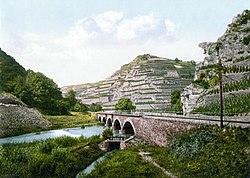Ahr (wine region)
| Wine region | |
 |
|
| Years of wine industry | c. AD 893 |
|---|---|
| Country | Germany |
| Part of | Rhineland-Palatinate |
| Size of planted vineyards | 539 ha (2010) |
| Varietals produced | Riesling, Silvaner, Ruländer (Pinot grigio), Kerner, Weißer Burgunder (Pinot blanc), Chardonnay, Ortega, Dornfelder, Spätburgunder (Pinot noir), Portugieser, Regent, Merlot, Dunkelfelder, Cabernet Sauvignon, Frühburgunder, Acolon, Cabernet Mitos |
| Wine produced | 33,624 hl, 62.4 hl/ha |
Ahr is a wine region (Anbaugebiet) for quality wine in Germany, and is located in the valley of the river Ahr, a tributary of Rhine, and is situated in the federal state of Rhineland-Palatinate. With only 558 hectares (1,380 acres) of vines as of 2008, it is one of smaller of Germany's 13 regions. Despite its northern location (it is for example situated north of Mosel region) it primarily produces red wines, and red grape varieties account for 86% of the vineyard area, which is more than in any other German wine region.
It is believed that vines were cultivated in the Ahr valley already in Roman times, as is the case with nearby Mosel, although definite documentary evidence to this effect seems to be lacking. However, a property list of the Benedictine Prüm Abbey drawn up in the year 893 AD, called the Prümer Urbar, lists vineyards in eight Ahr locations, so at least at this time, winemaking in the Ahr region was established.
Situated between 50° and 51° north, Ahr is the world's most northern region dominated by red wine grapes. So far north, very good sites with a warm microclimate are needed to properly ripen red wine grapes, and the Ahr vineyards are said to have a "Mediterranean" microclimate. Most vineyards are located on terraced slopes facing southwest to southeast along the middle and lower portions of river Ahr, over a stretch of 25 kilometers, from Altenahr to the Rhine. The wine-growing parts of the Ahr valley enjoy protection from the Eifel mountains resulting in a favoured mesoclimate.
Soils vary between slate, basalt and greywacke clay of volcanic origin.
...
Wikipedia
